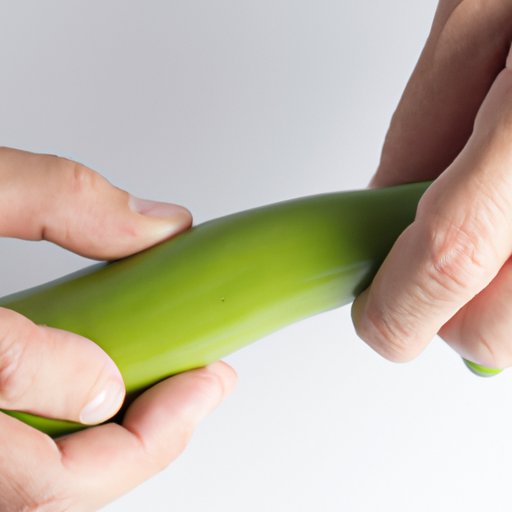
Introduction
A gallbladder attack can be an incredibly painful experience for anyone who’s had one. With symptoms including severe upper abdominal pain, nausea, and vomiting, it’s important to know how to stop a gallbladder attack before it gets worse.
Learning how to manage a gallbladder attack and prevent future ones from occurring can help you maintain the quality of your daily life. In this article, we’ll explore immediate remedies to ease a gallbladder attack and prevention strategies to avoid future attacks.
Understanding the Symptoms of a Gallbladder Attack and Why it Occurs
Before discussing how to stop a gallbladder attack, it’s important to understand the symptoms and causes.
A gallbladder attack is a sudden pain that occurs in the upper part of the abdomen, usually caused by the inflammation of the gallbladder. Common symptoms of a gallbladder attack include severe pain in the upper right or middle part of the abdomen, lasting anywhere from a few minutes to several hours. Additional symptoms can include nausea, vomiting, gas, or feeling full after eating only a small amount of food.
Gallbladder attacks are usually caused by blockage of the ducts by gallstones, inflammation, or injury to the gallbladder. However, other factors like unhealthy eating habits, rapid weight loss, and hormonal imbalances can trigger gallbladder attacks.
Immediate Remedies to Ease a Gallbladder Attack
Immediate treatment of gallbladder attacks can help reduce the severity of symptoms and prevent future complications. Here are a few immediate remedies to try when experiencing a gallbladder attack:
Types of medication that can help alleviate symptoms
Nonsteroidal anti-inflammatory drugs (NSAIDs) such as ibuprofen or naproxen can help reduce inflammation, alleviate pain, and fever that may accompany a gallbladder attack. Antacids such as simethicone or aluminum hydroxide help to relieve discomfort from bloating and gas pressure the patient may feel.
Dosages and precautions when taking medication
While medication can be helpful, it’s important to talk to a healthcare professional first before taking anything to prevent possible side-effects and drug interactions. Overdosing on NSAIDs can have severe side-effects like stomach bleeding, gastrointestinal perforation while combining them with antacids and other drugs can lead to various complications.

Practicing Deep Breathing Techniques and Relaxation Exercises
Deep breathing exercises and relaxation techniques can help you manage the pain and discomfort that comes with a gallbladder attack. Here’s how to perform deep breathing techniques:
Explanation of how deep breathing and relaxation exercises can help
Deep breathing exercises create a calming effect on the body, lowering blood pressure, improving oxygenation and circulation. By helping your muscles to relax, breathing exercises can help reduce tension in the body, alleviating pain, and easing symptoms of a gallbladder attack. It can further decrease anxiety and stress levels associated with gallbladder attacks
Step-by-step instructions for practicing these techniques
The following are the steps to follow in practicing deep breathing exercises:
- Find a quiet and comfortable place to sit down.
- Close your eyes and put your hands on your belly, breathing in slowly through your nose.
- Fill your lungs with air, hold for three seconds, then exhale through your mouth.
- Repeat for three minutes, breathing in and out deeply and slowly.
Applying Heat Therapy to the Affected Area of the Abdomen
Heat therapy is an effective way to reduce pain and pressure resulting from gallbladder attacks.
Explanation of how heat therapy can help
Heat therapy helps to increase blood flow to the affected areas, helping to reduce inflammation, ease pain, and relax muscles. The warmth of the heat also provides comfort and helps to relieve cramps, spasms and tension of the muscles associated with the gallbladder attack.
Techniques for applying heat therapy
The following steps will help you to apply heat therapy during a gallbladder attack:
- Choose a heating pad or hot water bottle to apply heat.
- Wrap the heating pad or hot water bottle in a towel to prevent burning your skin
- Place the heating pad or hot water bottle on the affected area of the abdomen for 20 minutes
- Repeat this process every hour, or as often as necessary, until symptoms diminish
Avoiding Trigger Foods That Can Cause Gallbladder Attacks in the Future
Identifying and avoiding trigger foods, which can cause future gallbladder attacks, is essential for long-term management of this condition.
Explanation of what trigger foods are and how to identify them
Trigger foods are those that cause discomfort and inflammation in the gallbladder, which can lead to gallstones and gallbladder attacks. They include foods high in fats, processed foods, fried foods and spicy foods. By keeping a food diary, you can identify which foods trigger your symptoms.
List of common trigger foods to avoid
The following foods are often considered common trigger foods to avoid:
- Fried Foods
- Dairy Products
- High-Fat Foods
- Processed Foods
- Spicy Foods
Drinking Plenty of Water and Staying Hydrated
Drinking plenty of water can promote the flow of bile in your system, which may help prevent gallstones and prevent future gallbladder attacks.
Explanation of why staying hydrated is important
Staying hydrated helps to flush out toxins from your body, promoting healthy liver and bile function, reducing bile congestion and stone formation, and promoting digestion. Remember to avoid dehydration, which can worsen symptoms during a gallbladder attack.
Tips for getting enough water throughout the day
It can be difficult to remember to drink enough water each day. Here are a few tips to help you stay hydrated:
- Carry a reusable water bottle and drink from it throughout the day.
- Set reminders on your phone or computer to drink water frequently
- Increase your intake of foods with high water content as it will also keep you hydrated throughout the day such as, cucumbers, lettuce, watermelon and oranges.
Knowing When to Seek Medical Attention and What Procedures May Be Necessary to Prevent Future Attacks
It’s important to recognize when you need to seek medical attention and what procedures may be necessary to prevent future gallbladder attacks.
Signs that medical attention is necessary
You should consider seeking medical attention if you’re experiencing severe or prolonged pain, a high fever, or jaundice. Seek emergency attention if you experience severe vomiting or nausea, or if your skin or eyes have a yellow tinge.
Overview of procedures like surgery and medication that can prevent future attacks
Procedures like cholecystectomy, shock-wave therapy, and medications can help prevent future gallbladder attacks. A doctor may recommend these procedures based on your medical history, the severity of your symptoms, and the cause of your gallbladder attacks.
Conclusion
In summary, there are various immediate remedies and prevention strategies for how to stop a gallbladder attack. By following the techniques outlined in this article, such as practicing deep breathing exercises, applying heat therapy, avoiding trigger foods, drinking water, and knowing when to seek medical attention, you can prevent gallbladder attacks from occurring and maintain control over your condition.
Don’t let the discomfort of a gallbladder attack dictate your life- take the necessary steps to manage it and improve your overall health and wellbeing.




